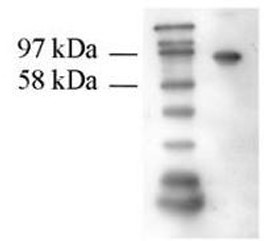Anti-Transglutaminase-2 (TG2) Antibody (90021)
Anti-Transglutaminase-2 (TG2) Antibody (90021)
Product No.: 90021
- -
- -
Clone 7D2 Target Transglutaminase-2 (TG2) Formats AvailableView All Product Type Monoclonal Alternate Names EC 2.3.2.13, Erythrocyte transglutaminase, Heart Gα(h, hhGα(h, Isopeptidase TGM2, EC 3.4.-.-, Protein Gα(h, G(h, Protein-glutamine deamidase TGM2, EC 3.5.1.44, Protein-glutamine dopaminyltransferase TGM2, EC 2.3.1.-, Protein-glutamine histaminyltransferase TGM2, EC 2.3.1.-, Protein-glutamine noradrenalinyltransferase TGM2, EC 2.3.1.-, Protein-glutamine serotonyltransferase TGM2, EC 2.3.1.-, Tissue transglutaminase, tTG, tTgase, Transglutaminase C, TG(C, TGC, TGase C, Transglutaminase H, TGase H, Transglutaminase II, TGase II, Transglutaminase-2, TG2, TGase-2, hTG2 Isotype Mouse IgG3 Applications ICC , WB |
Data
- -
- -
Antibody DetailsProduct DetailsHost Species Mouse Immunogen Purified TG2 from guinea pig liver (accession no. P21980). Formulation Lyophilized, 0.1M Tris, 0.1M glycine, 2% sucrose, 1mg/ml. State of Matter Lyophilized Product Preparation Purified by Protein A affinity chromatography Storage and Handling This product is stable for at least one (1) year at -20°C to -70°C. Reconstituted product should be stored in appropriate aliquots to avoid repeated freeze-thaw cycles. Country of Origin USA Shipping Next Day 2-8°C Applications and Recommended Usage? Quality Tested by Leinco Immunoblotting: use at 1-5ug/mL. A band of ~80kDa is detected.
Immunocytochemistry: use at 2- 10ug/mL. These are recommended concentrations. Enduser should determine optimal concentrations for their applications. Each investigator should determine their own optimal working dilution for specific applications. See directions on lot specific datasheets, as information may periodically change. DescriptionSpecificity Mouse Monoclonal Antibody specific to Transglutaminase-2 (TG2) Background Transglutaminase 2 (TG2) is a multi- domain, multi-functional enzyme that post-translationally modifies proteins by catalyzing the formation of inter- molecular isopeptide bonds between glutamine and lysine side-chains. It plays a role in diverse biological functions, including extracellular matrix formation, integrin mediated signaling, and signal transduction involving 7- transmembrane receptors. While some of the roles of TG2 under normal physiological conditions remain obscure, the protein is believed to participate in the pathogenesis of several unrelated diseases including celiac sprue, neurodegenerative diseases, and certain types of cancer. Antigen DetailsFunction Calcium-dependent acyltransferase that catalyzes the formation of covalent bonds between peptide-bound glutamine and various primary amines, such as gamma-amino group of peptide-bound lysine, or mono- and polyamines, thereby producing cross-linked or aminated proteins, respectively (PubMed:9252372, PubMed:23941696, PubMed:31991788). Involved in many biological processes, such as bone development, angiogenesis, wound healing, cellular differentiation, chromatin modification and apoptosis (PubMed:1683874, PubMed:7935379, PubMed:9252372, PubMed:27270573). Acts as a protein-glutamine gamma-glutamyltransferase by mediating the cross-linking of proteins, such as ACO2, HSPB6, FN1, HMGB1, RAP1GDS1, SLC25A4/ANT1, SPP1 and WDR54 (PubMed:23941696, PubMed:24349085, PubMed:29618516, PubMed:30458214). Under physiological conditions, the protein cross-linking activity is inhibited by GTP; inhibition is relieved by Ca(2+) in response to various stresses (PubMed:7649299, PubMed:7592956, PubMed:18092889). When secreted, catalyzes cross-linking of proteins of the extracellular matrix, such as FN1 and SPP1 resulting in the formation of scaffolds (PubMed:12506096). Plays a key role during apoptosis, both by (1) promoting the cross-linking of cytoskeletal proteins resulting in condensation of the cytoplasm, and by (2) mediating cross-linking proteins of the extracellular matrix, resulting in the irreversible formation of scaffolds that stabilize the integrity of the dying cells before their clearance by phagocytosis, thereby preventing the leakage of harmful intracellular components (PubMed:7935379, PubMed:9252372). In addition to protein cross-linking, can use different monoamine substrates to catalyze a vast array of protein post-translational modifications: mediates aminylation of serotonin, dopamine, noradrenaline or histamine into glutamine residues of target proteins to generate protein serotonylation, dopaminylation, noradrenalinylation or histaminylation, respectively (PubMed:23797785, PubMed:30867594). Mediates protein serotonylation of small GTPases during activation and aggregation of platelets, leading to constitutive activation of these GTPases (By similarity). Plays a key role in chromatin organization by mediating serotonylation and dopaminylation of histone H3 (PubMed:30867594, PubMed:32273471). Catalyzes serotonylation of 'Gln-5' of histone H3 (H3Q5ser) during serotonergic neuron differentiation, thereby facilitating transcription (PubMed:30867594). Acts as a mediator of neurotransmission-independent role of nuclear dopamine in ventral tegmental area (VTA) neurons: catalyzes dopaminylation of 'Gln-5' of histone H3 (H3Q5dop), thereby regulating relapse-related transcriptional plasticity in the reward system (PubMed:32273471). Regulates vein remodeling by mediating serotonylation and subsequent inactivation of ATP2A2/SERCA2 (By similarity). Also acts as a protein deamidase by mediating the side chain deamidation of specific glutamine residues of proteins to glutamate (PubMed:9623982, PubMed:20547769). Catalyzes specific deamidation of protein gliadin, a component of wheat gluten in the diet (PubMed:9623982). May also act as an isopeptidase cleaving the previously formed cross-links (PubMed:26250429, PubMed:27131890). Also able to participate in signaling pathways independently of its acyltransferase activity: acts as a signal transducer in alpha-1 adrenergic receptor-mediated stimulation of phospholipase C-delta (PLCD) activity and is required for coupling alpha-1 adrenergic agonists to the stimulation of phosphoinositide lipid metabolism (PubMed:8943303). {UniProtKB:P08587, UniProtKB:P21981, PubMed:12506096, PubMed:1683874, PubMed:18092889, PubMed:20547769, PubMed:23797785, PubMed:23941696, PubMed:24349085, PubMed:26250429, PubMed:27131890, PubMed:29618516, PubMed:30458214, PubMed:30867594, PubMed:31991788, PubMed:32273471, PubMed:7592956, PubMed:7649299, PubMed:7935379, PubMed:8943303, PubMed:9252372, PubMed:9623982, PubMed:27270573}.; [Isoform 2]: Has cytotoxic activity: is able to induce apoptosis independently of its acyltransferase activity. {PubMed:17116873}. NCBI Gene Bank ID UniProt.org Research Area Enzymes References & CitationsTechnical Protocols |
Formats Available
- -
- -
Prod No. | Description |
|---|---|
90020 | |
90021 |



